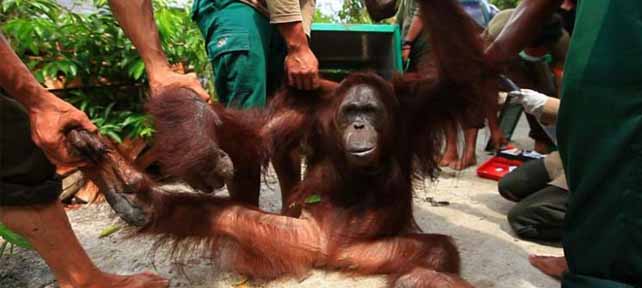
Visiting Orphans in Palangkaraya
Visiting Orphans in Palangkaraya
NETWORK shows 8 o’clock in the morning, about a dozen officers prepare at the river dock. They are busy preparing a breakfast menu. The food they serve is not for humans, but for their care primates, namely orangutans.
Baskets of yam, cucumber and corn are put on the boat. Every day the officers supply 300 to 400 kg of food for orangutans placed on Kaja Island and Bengamat Island, in Sei Gohong Village, Palangkaraya, Central Kalimantan.
Three boats skidded along the Rungan River and split the forest towards Kaja and Bengamat Islands. These two islands surrounded by rivers were chosen as pre-release sites for orangutans participating in the rehabilitation program, before they were actually released into their natural habitat forests.
These officers came from the Nyaru Menteng Borneo Orangutan Survival Foundation (BOS) which runs an orangutan rehabilitation and introduction program.
“There are around 49 individuals on Kaja Island and around 139 individuals in Bengamat Island,” explained Monterado Friedman, communication coordinator of the BOS Foundation in Nyaru Menteng.
About 20 minutes the boat arrives on Kaja Island. The clerk descended and placed a basket of fruit on a wooden platform where the orangutans ate.
“Fruit …” shouted the officer repeatedly.
The sentence is to call the orangutan as a sign that the food has arrived. And sure enough, one by one the orangutans came over and they immediately ate the food served.
“I see them like they are gathering in a food stall enjoying food, their movements are the same as ours. We should not be too close and may not get off the boat, “said Dayu Hatmanti, Explore Indonesia’s host who aired on Kompas TV, while taking part in the activity of feeding orangutans.
Orangutans included in the rehabilitation program are orangutans who have been displaced from their habitat and lost their mothers, due to human development activities. Many forests are cleared and converted as oil palm plantations. Orangutans who lose their homes then enter the people’s fields and are considered pests so they are destroyed.
Some orangutans are hunted and traded to be used as pets. Though caring for orangutans is very risky, because orangutans and humans have DNA similarities up to 97 percent, making it easy to transmit diseases to each other.
Orangutan babies who lost their mothers and could be rescued were then put into rehabilitation centers. Because they live without their parents, many orphaned orangutan children lose their natural instincts.
They must learn to climb trees, hang, and find their own food. In this orangutan school they are taught to return to being fully wild animals.
Indonesia should be proud because orangutans only exist in Kalimantan and Sumatra. But unfortunately the orangutan population is now an emergency and almost extinct. In Kalimantan there are only 54,000 individuals and in Sumatra there are 6,500 orangutans left.
“Saving orangutans means we also save the forest. Whereas we know forests are the lungs of the world, and these orangutans are the umbrella species. So when saving orangutans, other species are also saved, “said Denny Kurniawan, manager of the Nyaru Menteng BOS Foundation program.
How is the continuation of orangutans in Kalimantan? Watch the full story in the Indonesian Explore Program in the Palangkaraya episode at Kompas TV, Wednesday (11/05/2014) at 8:00 p.m. WIB. (Anjas Prawioko)
Source:Kompas.com






